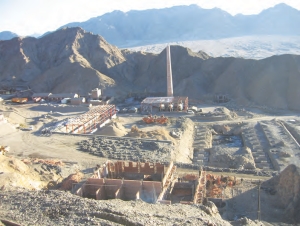As the first North American gold producer in China, Eldorado Gold (ELD-T, EGO-X) has a lot to smile about.
Its 90%-owned Tanjianshan gold mine in western China’s remote Qinghai province moved into commercial production in February 2007, after a feasibility study demonstrated the project had promise in April 2005.
In its first year, Tanjianshan produced 138,162 oz. gold at a cash operating cost of US$288 per oz. last year.
This year, the Vancouver-based company is banking on production of 109,000 oz. gold at a cash operating cost of US$289 per oz.
It’s already off to a good start: In the second quarter, Tanjianshan produced 31,890 oz. gold at a cash cost of US$229 per oz.
Eldorado owns the majority of the gold mine, with Dachaidan Mining and the First Brigade for Geology and Mineral Exploration of Qinghai province each holding a 5% stake.
Tanjianshan’s measured and indicated resources are pegged at 10.99 million tonnes grading 3.44 grams gold per tonne for 1.21 million oz. gold. The mine also has an inferred resource of 1.69 million tonnes grading 2.69 grams gold for total contained gold of 146,000 oz.
Proven and probable reserves have been estimated at 7.34 million tonnes grading 3.96 grams gold for about 934,000 oz. gold.
Tanjianshan is situated on 338 sq. km of land in Qinghai, where Eldorado holds four exploration and two mining licences.
The mine consists of two separate deposits — Qinglongtan (QLT) and Jinlonggou (JLG).
At QLT, gold mineralization is confined to a 50 to 60 east-dipping shear zone that cuts across a sequence of phyllites and marbles. The shear zone is typically 5 to 10 metres wide, and is open at depth, the company says.
At JLG, surface mineralization is dominantly controlled by steeply dipping, north-east-trending shear zones within carbonaceous phyllites. At depth and in the eastern part of the deposit, mineralization is associated with sub-horizontal diorite porphyry sills.
At QLT, the gold occurs mainly as fine-grained free gold. It is associated with pyrite and is non-refractory. At JLG, gold is associated with pyrite and to a lesser extent arsenopyrite and is mainly refractory.
Mining has now shifted to the Jinlonggou pit. Eldorado spent US$10.3 million on capital expenses, primarily on its sulphide ore-processing project, which it forecasts will be completed in the fourth quarter.
Eldorado drilled 6,879 metres in 39 holes, primarily south of the Jinlonggou pit limit at Xijingou, and at Qinlongtan south, where the target horizon is similar to the mineralization found at the main QLT deposit. The company says in the third quarter, it will start drilling in the Qinlongtan deep zone, targeting high-grade ore mined at QLT and extending beneath the final pit floor.
In Toronto, Eldorado recently traded at $8.26 per share. The stock has a 52-week trading range of $9.01-5.06.
On the American Stock Exchange, Eldorado is trading at about US$7.97 per share, with a 52-week range of US$4.78-9.34.
Outside China, Eldorado owns the operating Kisladag gold mine in Turkey, and is building another in the country called Efemcukuru. It is also building an iron ore mine (Vila Nova) in Brazil.
In the second quarter, Eldorado sold 88,610 oz. gold from its Tanjianshan and Kisladag mines at a realized average price of US$904 per oz.
It also reported that it has released US$10.8 million in restricted cash as a result of loan repayments from Tanjianshan.
Consolidated net income for the company in the second quarter reached US$25.2 million and revenues increased 7% over the same quarter in 2007 due to increases in selling prices, which were partially offset by fewer ounces sold.


Be the first to comment on "Clear skies in Qinghai for Eldorado Gold (September 08, 2008)"